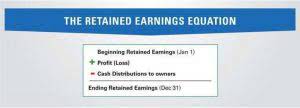
This can be found in the balance of the previous year, under the shareholder’s equity section on the liability side. In our example, December 2023 is the current year for which retained earnings need to be calculated, so December 2022 would be the previous year. Meaning the retained earnings balance as of December 31, 2022 would be the beginning period retained earnings for the year 2023.
What is the retained earnings formula?
- Retained earnings are recorded on the company’s balance sheet under shareholders’ equity, showing how much profit has been reinvested in the business rather than paid out to shareholders.
- Retained earnings are calculated by subtracting dividends from the sum total of the retained earnings balance at the beginning of an accounting period and the net profit or loss from that accounting period.
- Retained earnings represent the total profit to date minus any dividends paid.Revenue is the income that goes into your business from selling goods or services.
- Retained earnings represent a useful link between the income statement and the balance sheet, as they are recorded under shareholders’ equity, which connects the two statements.
- Retained Earnings is very important as it reports how the company is growing with respect to its profit.
- The articles and research support materials available on this site are educational and are not intended to be investment or tax advice.
For growing companies, a rising retained earnings balance often signals healthy reinvestment in the business. For established companies, a balanced approach between retained earnings and dividends can indicate a well-managed strategy to keep investors happy while fueling growth. At the end of each accounting period, retained earnings are reported on the balance sheet as the accumulated income from the prior year (including the current year’s income), minus dividends paid to shareholders. In the next accounting cycle, the RE ending balance from the previous accounting period will now become the retained earnings beginning balance. In financial modeling, it’s necessary to have a separate schedule for modeling retained earnings.
Why are retained earnings important for small business owners?

Retained earnings refer to the portion of a company’s profits that are reinvested back into the business, rather than being distributed to shareholders. Over time, retained earnings can have a significant impact on a company’s growth and profitability. From a more cynical view, even positive growth in a company’s retained earnings balance could be interpreted as the management team struggling to find profitable investments and opportunities worth pursuing. If a company has no strong growth opportunities, investors would likely prefer to receive a dividend. Therefore, the company must balance declaring dividends and retained earnings for expansion.

How Net Income Impacts Retained Earnings
- A strong retained earnings figure suggests that a company is generating profits and reinvesting them back into the business, which can lead to increased growth and profitability in the future.
- If your business currently pays shareholder dividends, you’ll need to subtract the total paid from your previous retained earnings balance.
- Retained earnings also provide a financial cushion, allowing a company to weather economic downturns, pay off debt, or manage unexpected expenses without raising additional capital.
- However, some companies with long-standing profitability may occasionally report negative retained earnings.
- The growing retained earnings balance over the past few years could suggest that the company is preparing to use those funds to invest in new business projects.
- The figure is calculated at the end of each accounting period (monthly/quarterly/annually).
At the end of the period, you can calculate your final Retained Earnings balance for the balance sheet by taking the beginning period, adding any net income or net loss, and subtracting any dividends. The “Retained Earnings” line item is recognized within the shareholders’ equity section of the balance sheet. In simple words, the retained earnings metric reflects the cumulative net income of the company post-adjustments for the distribution of any dividends to shareholders. However, some companies with long-standing profitability may occasionally report negative retained earnings.
Step 2: State the Balance From the Prior Year
When expressed as a percentage of total earnings, it is also called the retention ratio and is equal to (1 – income summary the dividend payout ratio). This formula calculates the retained earnings for the current period by adding the beginning retained earnings to the net income (or subtracting if there was a net loss) and then subtracting any dividends paid to shareholders. If your business is seasonal, like lawn care or snow removal, your retained earnings may fluctuate substantially from one quarter to the next. Therefore, the calculation may fail to deliver a complete picture of your finances.The other key disadvantage occurs when your retained earnings are too high. Excessively high retained earnings can indicate your business isn’t spending efficiently or reinvesting enough in growth, which is why performing frequent bank reconciliations is important. Lack of reinvestment and inefficient spending can be red flags for investors, too.That said, calculating your retained earnings is a vital part of recognizing issues like that so you can rectify them.
Now your business is taking off law firm chart of accounts and you’re starting to make a healthy profit which means it’s time to pay dividends. On the other hand, though stock dividends do not lead to a cash outflow, the stock payment transfers part of the retained earnings to common stock. For instance, if a company pays one share as a dividend for each share held by the investors, the price per share will reduce to half because the number of shares will essentially double. Because the company has not created any real value simply by announcing a stock dividend, the per-share market price is adjusted according to the proportion of the stock dividend.

This may indicate that the company doesn’t need to invest very much additional capital to continue to be profitable, which often means the extra funds are distributed to shareholders through dividends. Companies may pay out either cash or stock dividends, and in the case of cash dividends they result in an outflow of cash and are paid on a per-share basis. Retained earnings are reported on the balance sheet under shareholders’ equity because the retained earnings account represents exactly that—the retained earnings balance that essentially belongs to the company’s owners. The level of retained earnings can guide businesses in making important investment decisions. If retained earnings are low, it may be wiser to hold onto the funds and use them as a financial cushion in case of unforeseen expenses or cash flow issues rather than distributing them as dividends.

How To Calculate Retained Earnings on a Balance Sheet
In rare cases, companies include retained earnings on their income statements. The figure is calculated at the end of each accounting ending re formula period (monthly/quarterly/annually). As the formula suggests, retained earnings are dependent on the corresponding figure of the previous term.

Leave a Reply